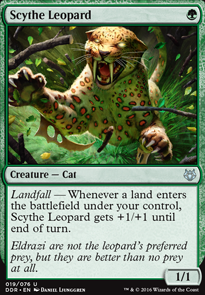Let's go up the curve, starting from one. You run twelve one-drops, and you really don't want to start the game without one. Four Scythe Leopard and four Monastery Swiftspear are both one-power threats that have the potential to get huge as the game goes on. Meanwhile, Zurgo Bellstriker is just a 2/2 on turn one, straight-up. Hard to argue with that.
In the two slot, you have
Makindi Sliderunner
and
Snapping Gnarlid
taking up seven slots. These are very nearly the same card, each costing one and a colored mana, having 2 power, and having a landfall trigger that grants a temporary +1/+1 boost. Sliderunner trades one point of toughness for trample as compared to the Gnarlid, and for that reason, you should lean toward the Sliderunner on turn 2 if you have the choice. If you don't though, Gnarlid is just fine. Our other two-drop is
Mage-Ring Bully
. Like the Monastery Swiftspear, it's an X/2 with Prowess (which will become relevant later, I promise!). Unlike the Swiftspear, the Bully starts at two power, justifying the extra mana. Being forced to attack each turn isn't a huge drawback, since ideally, you want to be doing that anyway. Bonus flavor points if the Bully gets chumped by a Jace, Vryn's Prodigy
.
Your sole three-drop is
Valakut Predator
, and there's only three copies. The Predator is certainly a solid threat, but in many cases you'll find you actually get a little more mileage out of going wide and dropping a lot of creatures. With that said, if you haven't got anything better to do on turn three, or if you need to rebuild after a Languish, Valakut Predator is a good start.
Now we get into the spells. This is where you can get really explosive.
Swell of Growth
is basically your budget
Atarka's Command
. You get a free land drop, and you get to pump a creature to get in for extra damage. Casting Swell also triggers prowess for Swiftspear and Bully, letting you get in for even more damage. This is what I meant when I said that going wide is valuable: This deck runs lots of creatures that pump based on non-targeted events like land drops or casting spells. With that in mind, the more creatures you have, the more additional value you get out of each of those events. For example, playing a Forest is stronger when you have a Scythe Leopard and a Makindi Sliderunner than when you have, say, just a Zurgo Bellstriker on the table.
As with some mono-red decks (and, indeed, Atarka Red), most of your spells are pump spells. In addition to Swell of Growth, you also run four Temur Battle Rage and three Become Immense. Temur Battle Rage takes all of your pumps and triggers and effectively doubles them, while providing a prowess trigger of its own. On top of that, stack enough pumps, and the target gains trample, virtually guaranteeing some damage gets through. The remaining two spell slots go to Wild Slash. That's a great card for taking out smaller threats that might clog up the board, or closing out a tight game if you take a Languish just shy of the finish line.
The land base is very simple: Four Evolving Wilds, eleven Mountains, and eight Forests. Sadly, on a budget, you can't do much with fetch lands, as explosive as they can be. Feel free to experiment with Blighted Woodland or Blighted Gorge. Be warned, though; we found they were too color-restrictive, and their effects were too slow to get out, costing four and five mana, respectively.
Let's talk matchups and sideboarding. Against midrange and control decks, you want to mulligan aggressively for a fast opening hand with multiple one- and two-drops. Between costlier spells and slower, greedier mana bases, those decks are slower than ever. However, thanks to expensive but powerful cards and, well, slower, greedier mana bases, those same decks can lock you down entirely once they get up and running. Don't give them the chance. If you need sideboard cards,
Outpost Siege
can help keep you from floundering in the long game (if it comes to that). Roast is a good pickup to handle bigger bodies like the ever-present Siege Rhino. Neither is particularly expensive to buy or trade for. Scab-Clan Berserker is also fairly cheap and can provide you with a good way to take advantage of shields-down moments against control. It'll take down two damage on the attack and at least another two when your opponent gets rid of it.
Against aggressive decks, you actually have some pretty fun options. Jaddi Offshoot can substitute in for one of your one-drops and completely stall out the early game, while also padding out your life total to counter the aggressive push. Along similar lines, Retreat to Kazandu also gives you some life gain into the late game, and it also lets you build up your creatures to outclass your opponent's.
Boiling Earth
can take out X/1s and tokens; plus, if the game somehow lasts long enough that you get to awaken it, you suddenly outclass anything else on the board. If you're facing off against Hangarback Walker, it might be worth looking into
Touch of the Void
.
Built by Armstrong of The Mana Source--for more info and strategy ideas, including some advice for big-budget beef-ups, check out the deck tech video on our YouTube channel!

